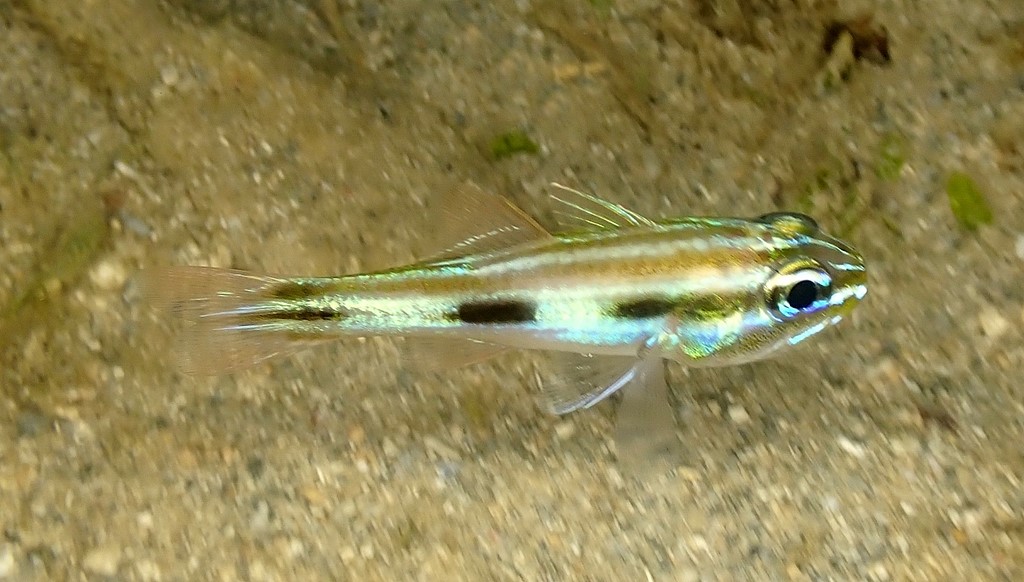OSTORHINCHUS NOVEMFASCIATUS - (CUVIER, 1828)
Picture courtesy of: Amaury Durbano
Actinopterygii (Gigaclass) > Actinopteri (Class) > Teleostei (Subclass) > Gobiiformes (Order) > Apogonoidei (Suborder) > Apogonidae (Family) > Apogoninae (Subfamily) > Ostorhinchus (Genus)
Apogon à neuf lignes, Nineline cardinalfish, Nine-banded cardinalfish, Nine-banded soldier-fish, Nine-line cardinalfish, Three-line cardinalfish
Synonymes
Apogon fasciatus (Quoy & Gaimard, 1825)
Actinopterygii (Gigaclass) > Actinopteri (Class) > Teleostei (Subclass) > Gobiiformes (Order) > Apogonoidei (Suborder) > Apogonidae (Family) > Apogoninae (Subfamily) > Ostorhinchus (Genus)
Apogon à neuf lignes, Nineline cardinalfish, Nine-banded cardinalfish, Nine-banded soldier-fish, Nine-line cardinalfish, Three-line cardinalfish
Synonymes
Apogon fasciatus (Quoy & Gaimard, 1825)
Apogon novemfasciatus (Cuvier, 1828)
Lovamia novemfasciata (Cuvier, 1828)
Lovamia novemfasciata (Cuvier, 1828)
-----------------------------
Description
Dorsal spines (total): 8; Dorsal soft rays (total): 9; Anal spines: 2; Anal soft rays: 8; Pectoral fin rays: 14; Lateral line scales: 24-28; Gill Rakers: 2-3 + 10-13. Greatest depth of body: 2.7-3.1 in SL. Max. length: 10.0 cm TL. Depth range: 1 - 4 m.
Color
Alternating dark brown and whitish stripes, dark stripes narrower than pale ones; Dark midlateral stripe extending onto caudal fin.
Etymology
Ostorhinchus: from Greek, osteon = bone + from Greek, rhynchos = beak. In reference to the bony jaws, very much advanced and jagged, which take the place of the teeth.
novemfasciatus: from Latin, novem = nine + from Latin, fascia, fascio = bundled, banded + from Latin suffix, -inus = pertaining to. Referring to nine black longitudinal bands, one on back, three on each side, and two under the body.
Original description: Apogon novemfasciatus Cuvier, 1828 - Type localities: Timor, Indonesia; Guam, Mariana Islands, western Pacific.
Description
Dorsal spines (total): 8; Dorsal soft rays (total): 9; Anal spines: 2; Anal soft rays: 8; Pectoral fin rays: 14; Lateral line scales: 24-28; Gill Rakers: 2-3 + 10-13. Greatest depth of body: 2.7-3.1 in SL. Max. length: 10.0 cm TL. Depth range: 1 - 4 m.
Color
Alternating dark brown and whitish stripes, dark stripes narrower than pale ones; Dark midlateral stripe extending onto caudal fin.
Etymology
Ostorhinchus: from Greek, osteon = bone + from Greek, rhynchos = beak. In reference to the bony jaws, very much advanced and jagged, which take the place of the teeth.
novemfasciatus: from Latin, novem = nine + from Latin, fascia, fascio = bundled, banded + from Latin suffix, -inus = pertaining to. Referring to nine black longitudinal bands, one on back, three on each side, and two under the body.
Original description: Apogon novemfasciatus Cuvier, 1828 - Type localities: Timor, Indonesia; Guam, Mariana Islands, western Pacific.
Distribution
Eastern Indian Ocean, western Pacific: Cocos-Keeling and Christmas islands and Indonesia, east to Line Islands and Samoa, north to southern Japan and Ogasawara Islands, south to northern Australia and New Caledonia.
Biology
Common in reef flats and shallow lagoons, often silty habitat. Also found in rocky reefs. Feeds on small crustaceans and fishes. Nocturnal species . Usually in pairs swimming close to shelter. Mouthbrooders. Distinct pairing during courtship and spawning.
Similar species
Ostorhinchus angustatus (Smith & Radcliffe, 1911) - Reported from New Caledonia - Link to the species (here).
Ostorhinchus nigrofasciatus (Lachner, 1953) - Reported from New Caledonia - Link to the species (here).
Ostorhinchus regula (Fraser & Randall, 2003) - Reported from Western Pacific: Mariana Islands and Caroline Islands. Alternating golden-brownish and white stripes on head and body in life, broad dark brown stripes on upper and lower caudal peduncle, midlateral stripe without a developed spot, whitish stripe extending onto last 2 anal rays; Elongated last dorsal and anal rays; 12-13 circumpeduncular scales; 13-14 well developed gill rakers on first gill arch. Depth range: 30 - 60 m.
Eastern Indian Ocean, western Pacific: Cocos-Keeling and Christmas islands and Indonesia, east to Line Islands and Samoa, north to southern Japan and Ogasawara Islands, south to northern Australia and New Caledonia.
Biology
Common in reef flats and shallow lagoons, often silty habitat. Also found in rocky reefs. Feeds on small crustaceans and fishes. Nocturnal species . Usually in pairs swimming close to shelter. Mouthbrooders. Distinct pairing during courtship and spawning.
Similar species
Ostorhinchus angustatus (Smith & Radcliffe, 1911) - Reported from New Caledonia - Link to the species (here).
Ostorhinchus nigrofasciatus (Lachner, 1953) - Reported from New Caledonia - Link to the species (here).
Ostorhinchus regula (Fraser & Randall, 2003) - Reported from Western Pacific: Mariana Islands and Caroline Islands. Alternating golden-brownish and white stripes on head and body in life, broad dark brown stripes on upper and lower caudal peduncle, midlateral stripe without a developed spot, whitish stripe extending onto last 2 anal rays; Elongated last dorsal and anal rays; 12-13 circumpeduncular scales; 13-14 well developed gill rakers on first gill arch. Depth range: 30 - 60 m.
Last update: 6, May 2024
